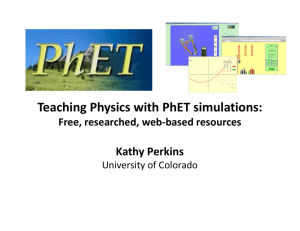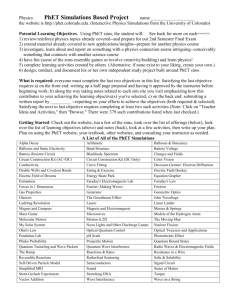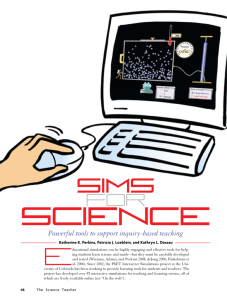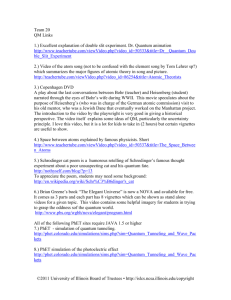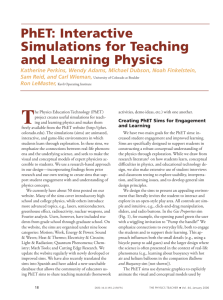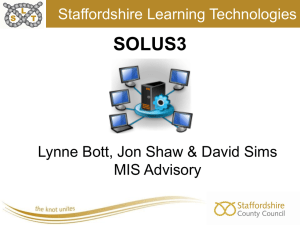PhET Interactive Simulations
advertisement
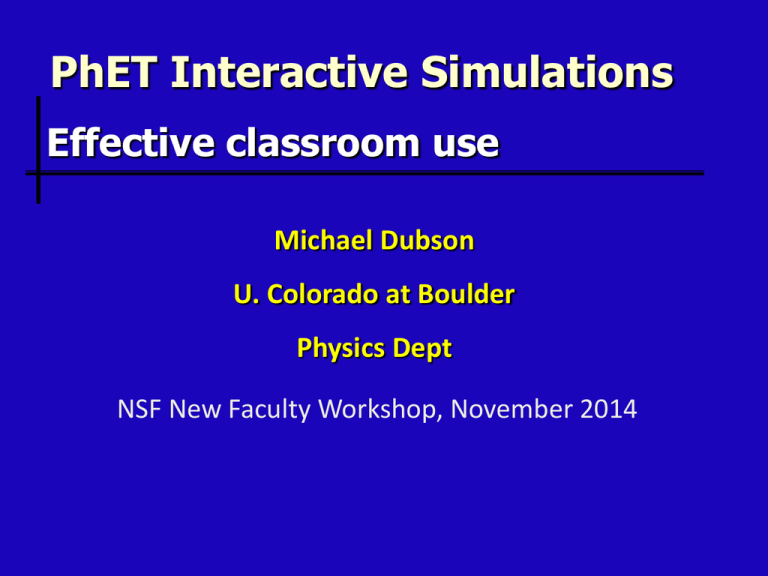
PhET Interactive Simulations Effective classroom use Michael Dubson U. Colorado at Boulder Physics Dept NSF New Faculty Workshop, November 2014 Have you ever visited the PhET site? A) No, tell me about it. B) I’ve visited the site, but not used the sims extensively. C) I’ve visited the site, and have played with several sims. D) I have used the sims in teaching a class. What is PhET? Originally, the Physics Education Technology project. • Suite of >100 interactive sims for science education. • Research-based and user-tested. • Java, Flash, and HTML5, run in browser or offline. • Physics, Math, Chemistry, Earth Science, Biology. • All FREE. Source code available. Where is PhET? http://phet.colorado.edu Examples: • Circuit Construction kit. • Masses and Springs. Who is PhET? Founded by Carl Wieman, 2002 Part of the Physics Education Research Group at CU Boulder University faculty, post-docs, K-12 teachers, software developers Prof. Kathy Perkins, CEO, education researcher, and grant-getter extraordinaire Accessible • Open-use License: Creative Commons - Attribution • Easy to translate for World-wide Use: Over 2700 translations in 59 languages, 34% of use outside US • >40 million sims run in 2012, exponential growth PhET around the world Serbia Vietnam Brazil Uganda What is PhET’s intended audience? • Originally, college freshmen, physics sims • Now, grade school through grad school sims are physics and math, many chemistry, some earth science and biology Arithmetic Workout QM Tunneling Build an Atom Normal Modes How might you use these sims in your school? Designed for versatile use • • • • • • Pre-lecture assignment Interactive Lecture Demonstration Clicker Questions In-class activity Lab or Recitation Homework No silver bullet: context and activity critical Versatile! Make easy to use Flexibility for you to Pick and choose which sims to use Customize use … to your environment and your learning goal Search database of activities (>500 by PhET or Teacher-users) Circuit Construction Kit CCK in grade school: “Make the light bulb light” CCK in college: “Explain why the light dims when you turn the heater on” Examples: • Friction • Energy Skate Park Example: Concept Tests I move the zero of PE up to the starting point of the Skateboarder (skateboarder still starts from rest). The total energy of the system is now: A) Zero B) positive C) negative D) Depends on the position of the skateboarder In the circuit, what happens to the brightness of bulb 1, when bulb 2 burns out? (When a bulb burns out, its resistance becomes infinite.) A) Bulb 1 gets brighter B) Bulb 1 gets dimmer. C) Its brightness remains the same. (Hint: What happens to the current from the battery when bulb 2 burns out.) If we increase the error bar on the date point shown, what happens to the slope of the best-fit line? A) It becomes more negative (line tilts CW). B) It becomes less negative (line tilts CCW). C) It does not change. Why is PhET successful? • • • • Diverse design team User interviews Classroom testing Research-based Design Philosophy • Inviting, intuitive interface, usable without instructions • Highly interactive: instant animated feedback as students explore • Accurate, dynamic visual representations; show the invisible • Allow actions that would be difficult or impossible in the real world • Game-like environment • Interface design that implicitly scaffolds inquiry Research-Based Design supports inquiry-learning Use accurate, dynamic visual representations Show the invisible Provide real-time, animated feedback as students play Allow actions that would be difficult or impossible in the real world Create a game-like environment Make simulations highly interactive Implicitly scaffold inquiry through design of controls and representations Provide an intuitive interface, usable without instructions PhET Design Process 2 – 12 months, $50K/sim Initial design Final design Research Interviews Classrooms Redesign Compare these tools: Your thoughts… PhET in popular culture Can PhET sims replace real equipment? • They can, but we don’t think they should. • Meant to compliment, not replace with lab equipment. • Sims lack real-world “dirt” effects, allow students to focus on physics concepts. Circuit Construction Kit vs. real circuits “When learning about the real world is better done virtually.. “, N.D. Finkelstein et al., Phys. Rev. ST Phys. Educ. Res. 1, 010103, 2005. Students who only used virtual circuits, did equally well on building real circuits final. Sims allow risk-free, rapid inquiry cycle. Do students learn if I just tell them to play with a sim? • Seldom. Guided inquiry essential. • Large data-base of classroom-tested activities available on the PhET site. What makes a good sim activity? • Minimum instruction. Detailed procedures inhibit student exploration. • Clear Learning Goals Give students the goal, not the procedure. In-Class activity or Lab Worse: Better: • Give directions on how to use the sim • Provide activity and do not offer any pointers on the sim itself • Result: Students are nervous, reluctant to try things, ask lots of questions about sim use, not learning goals. • Result: Students explore uninhibitedly, quickly find/learn all the controls, become the “owner” of the sim. Example Activity: Masses and Springs • 5-10 minutes of play – No instructions. • Challenge 1:Using data from the sim, make a graph that shows whether or not the springs obey Hooke’s Law. • Challenge 2: What is the mass of the red weight? • Challenge 3: Determine the spring constant in two different ways: with your graph from (1) and with the stopwatch. Cookbook directions (NOT effective): • Watch me while I show you the controls. • Measure the equilibrium extension of spring 1, for each of the 3 different known masses, and make a graph of stretch of the spring (on y-axis) vs. mass (on x-axis). From this, determine the spring constant k of the spring. Recall that Fspring = kx, where x is the stretch of the spring. Don’t forget that weight is mg, where g = 9.8 m/s2. What would you like to see in PhET? • Sim ideas? New features? ?? Door Prize! : You can see NEW sims in development, before they are published, at http://www.colorado.edu/physics/phet/dev The Future… • More sims • Compatibility with iPad • Classroom sim sharing How can you contribute? Report bugs Send us your ideas for new sims! Email: phethelp@colorado.edu How can PhET be free? Current budget > $1M / year NSF Hewlett Foundation The O’Donnell Foundation King Saud University University of Colorado Carl Wieman & Sarah Gilbert How can PhET stay free? • We’re not sure. • Major funding from grants not sustainable. • Seeking corporate sponsors, large and small donors. • Your advise or $$ gratefully accepted. PhET Interactive Simulations • Suite of >100 interactive simulations • Physics , Chemistry , Math Expanding into biology, earth science • Research-based and user-tested • Free! Online or downloadable. (~130 MB) • Easy to use and incorporate in class http://phet.colorado.edu Extra Slides Follow Designing Activities: What do students learn in each activity? Add 100 silver bromide pairs to the water. How many silver and bromide ions dissolve in the water? Repeat this for all salts. Investigate different salts. What features do salts have in common, and how do salts differ from each other? Old Acid-Base Solutions New Acid-Base Solutions Why is this sim better? Interview Study: Type of Guidance Compared two types of guidance Examined Student Behavior Open Conceptual Questions + Open Conceptual Questions Guided Activity In the “Bar Magnet” tab, identify all controls, … What does the “Strength” slider do? Free exploration of sim Results Guided Activity Student Mode: Students answer question and wait for the next. “OK, continue?” “Is that sufficient for step 2? Often don’t tie pieces together. Open Conceptual Questions Scientist-like Exploration: Explore via their own questioning “Oh, I wasn’t expecting that” “I was looking around to see if it was an effect of having more wires.” What did students explore? 12 features not mentioned in the Cookbook activity: Explored Just noticed Not noticed Open Q’s Cookbook
